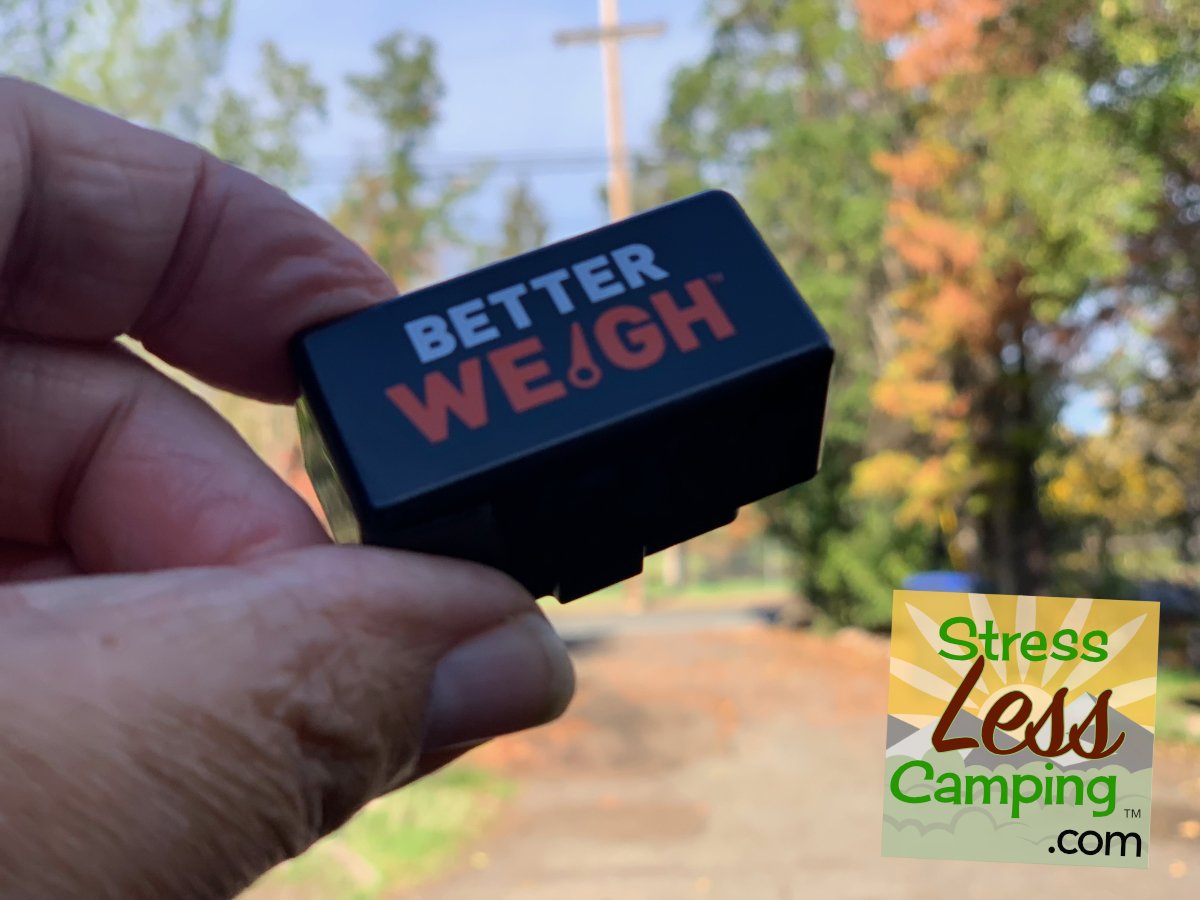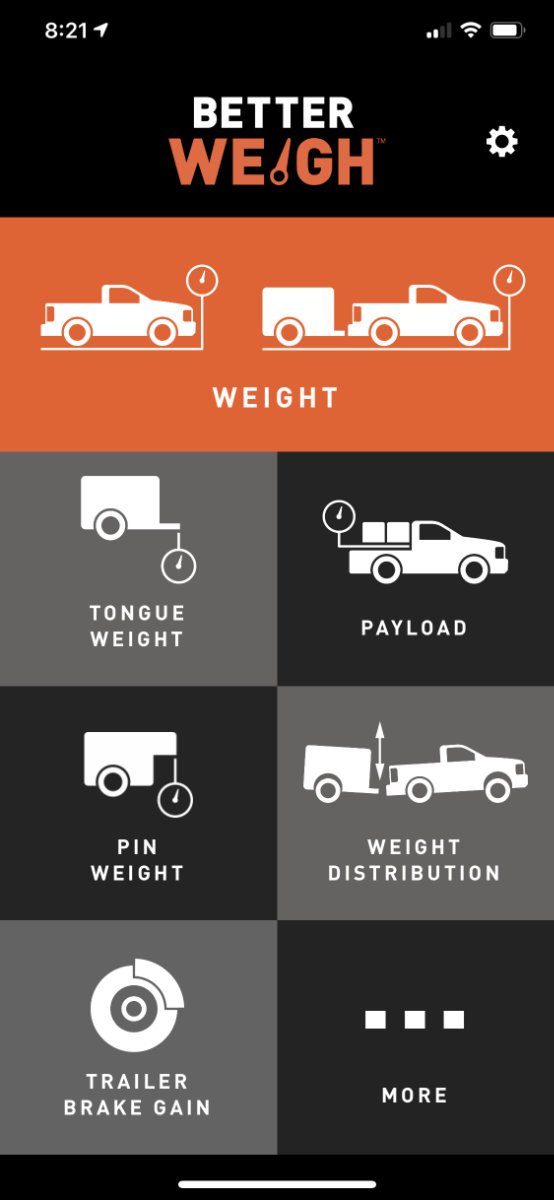Product review: Curt BetterWeigh OBDII weighing device
This review is for the Curt Better Weigh, a device that helps vehicle owners determine tow weight, cargo weight and other factors in their vehicle’s towing through the use of the OBD II system and a smart phone app via Bluetooth.
Curt, manufacturer of hitches of all sorts as well as other components, sent me a Better Weigh device to test out for you. Curt is a member of the Lippert Family - if you recognize that name you should as they are a manufacturer of all sorts of RV components including Curt products.
The BetterWeigh device itself.
What is it
The Curt Better Weigh is a device that hooks to your vehicle’s OBD II port and reads a combination of factors to deliver readings on vehicle weight, tongue weight, pin weight, payload and weight distribution.
It appears to use sensors in the device itself to measure the vehicle’s angle (how much the springs deflect when you hook up your trailer) and combines that with information from the vehicle’s computer to achieve other measurements. All of this is delivered via Bluetooth to your smart phone or tablet via a proprietary app.
The Curt Better Weigh uses what the company calls “TowSense™” technology. From the manufacturer, “TowSense™ technology is a digital towing scale system. Using an accelerometer circuit, TowSense™ measures changes in the velocity and pitch of your vehicle. It uses this data to calculate weights associated with towing and hauling.
Armed with TowSense™ technology, the BetterWeigh™ tongue weight scale wirelessly connects to your Apple or Android phone to display the weight of the vehicle, trailer, cargo / payload, tongue weight, pin weight, weight distribution and trailer brake gain.”
Setting it up
I plugged the Better Weigh into my 2015 Ram 1500’s OBD II port and went through the set-up. This means telling the system what kind of vehicle I have and, by inputting the serial number, it knows the year, make, model along with which engine, transmission and gear ratios are on the truck.
From there you drive the vehicle on a straight, flat road several time to get the calibration. This determines how much accelerator pedal input is used to achieve certain vehicle speed so you have a benchmark.
The set-up process is pretty specific but is necessary so the Better Weigh system establishes a benchmark for your vehicle and then whatever you’re towing or have as cargo in the bed.
Does it work?
After calibrating the Better Weigh with an empty truck I added my travel trailer, a 2017 Rockwood Mini Lite 1905s. That’s a relatively small and light trailer but the Better Weigh estimated that I’ve got over 550lbs of weight on the tongue of that thing. Considering that the trailer’s dry weight is about 2800lbs and it’s full of water and supplies for a week’s worth of camping at the beach I believe this to be fairly accurate.
The calibration phase also has an idea of what the truck weighs unloaded so I gave it a test to see what it thought my trailer weighed and it was closer to 4,200lbs. Let’s see - cast iron cook ware, a week’s worth of beer, winter clothing and blankets and 30 gallons of water.
I believe it was pretty close to accurate and this was like lying to yourself that the holidays didn’t pack on many pounds even though that lousy scale reads otherwise. In other words I would have guessed that the trailer was lighter than this but, in actuality, it wasn’t. While I didn’t drag it to a Cat scale to verify the numbers, I don’t have reason to think they were tremendously inaccurate.
I also ran the tests on the way home and the tongue weight did drop (no more fresh water but a full tank of black water, which is in the back of my trailer). Furthermore it estimated that the trailer was about 3800lbs which, again, seems accurate. I drank all the beer.
Worth it?
I’ve seen a few reviews of this device on line and some are really happy with it, others not. It seems the difference may be the vehicle itself. The Ram pickup line seems to work really well with this but I can’t speak to the other brands of vehicles.
Furthermore I think this is a decent way to get some idea of what’s going on but still no substitution for a Cat scale or equivalent. From my own experience I think the numbers it provides are reasonably accurate but certainly not certified as you’d get from a true scale.
According to Steve Kass from RV Weigh, who has weighed hundreds of RVs at FMCA rallies and other events, the number of RVs that are overweight is significant. Honestly it’s wise to have some idea of what you’re towing back there and how close you are to the capacity of your tow vehicle.
Considering how easy this device is to use and how handy it is for $99 on Amazon it seems well worth it, especially for anyone who might be even moderately close to the maximum towing capability of their vehicle.
The OBDII port - typically found beneath your vehicle’s instrument panel.
What is OBD II
As part of the overwhelming regulation in the auto industry all vehicles sold in 1996 and beyond need to have an On Board Diagnostics (OBD) port. This is a second-generation system so is labeled OBD II.
Essentially this gives anyone access to much of the technological functionality going on in the vehicle computer systems. Using a standardized connector the idea was that technicians can read what’s going on which helps them diagnose vehicles as they become ever more computerized.
Today a modern vehicle uses computer technology to manage the engine, transmission and often much more. Emissions sensors, oxygen sensors and so much more are the key to why our vehicles have more power and are more efficient at burning fuel when all systems are go. Yaw sensors, sway sensors, braking input, throttle input and other digital babysitters are the key to why cars are safer today - basically technology can replace a lot of the knowledge we used to have to keep our vehicles on the straight and narrow.
In fact my own truck utilizes some of these vehicle dynamic sensors to help eliminate trailer sway by applying braking to the trailer if it senses sway, which is what a smart driver would do but, let’s face it, we’ve all seen others who aren’t smart drivers.
Any complex technological system can also fail, and does, especially when combined with the tremendous heat and unforgiving realities under the hood of a vehicle.
Furthermore idiots like me can access the various functions in their vehicles and actually modify or hack them. My own Ram pickup has all sorts of computer subsystems for the body (lighting controllers, etc.), emissions, and more. The list of computers that appears when I get into the OBD II system is incredible.
These systems allow the Ram to shut off four of its eight cylinders to improve fuel economy when cruising but the level of computerization and sophistication can also be an issue when something goes haywire.
So when these systems go haywire the OBD II system was designed to allow a technician to peek in to what’s going on and use the OBD II system’s reporting to affect a change in less time.
Or, just modify the heck out of your truck’s electronics and then wonder why it runs funny.










